yogabuch / asanas / parivrtta parsva upavista konasana
parivrtta parsva upavista konasana
„twisted sideways upright angle“

 instructions and details with working links as PDF for download/print
instructions and details with working links as PDF for download/print
Feedback: We’d love to hear what you think about this description, give us feedback at:
postmeister@yogabook.org
last update: 12/30/2018
Name: parivrtta parsva upavista konasana
Trivial name: twisted side upright angle
Level: A
- Classification: A
- Contraindication
- Effects of
- Preparation
- follow-up
- derived asanas
- similar asanas
- diagnostics
- Instruction
- details
- Variants
Classification
classic: seated posture
physiological: trunk side bend with stretching of the hamstrings and the adductors
Contraindication
Lateral flexion of the lumbar spine can cause the known complaints to flare up again or contribute to their persistence in the case of disc problems in the lumbar spine, which is why this posture is contraindicated. Furthermore, the pelvis tilts in the hip joint towards the extended leg, which represents a stretching of the hamstrings and is contraindicated in the case of a PHT. In the case of pes anserinus syndrome, the posture can be performed if the disturbed area is not the insertion of the inner hamstrings.
Effects
- (501) Stretching the latissimus dorsi
depending on flexibility - (551) Stretching the quadratus lumborum
- (641) Stretching the muscles of the lumbar spine in the direction of lateral flexion
- (676) Stretching the oblique abdominal muscles obliqui abdomini
- (721) Stretching the hamstrings
- (751) Stretching the adductors
- (756) Stretching the gracilis
Preparation
On the side to which the upper body moves, the hamstrings is stretched similar to parivrtta janu sirsasana because of the extended leg and the lateral inclination of the pelvis, prepare with:
- uttanasana as a generally effective and efficient stretch of the ischiocrural group to prepare for flexion in the hip joints in this pose
- prasarita padottanasana very similar to uttanasana
- parsvottanasana as a stretch that goes beyond uttanasana
- pascimottanasana
- janu sirsasana
- tryangamukhaikapada pascimottanasana
- downface dog as another good preparation for the hamstrings when the pelvis is tilted powerfully
- hip opener 5 as a very effective stretch of the hamstrings that goes beyond uttanasana
- warrior 3 pose
- trikonasana
- parivrtta trikonasana
- parivrtta ardha chandrasana
The stretching ability of the latissimus dorsi may be limited, which means that the hands cannot be broughtto the contralateral outer footwithout an excess of stretching sensation in the upper side of the body , in which case all postures with 180°+ frontal abduction should help:
- downface dog, especially the „wide“ variation as a general stretch of the muscles of the shoulder joint
- Back extension, especially the „elevated “ variation as a general stretch for the muscles of the shoulder joint
- Right-angled handstand
- handstand
- Elbow stand
- Right-angled elbow stand
- Dog elbow stand
- Hyperbola as one of the most effective and efficient stretches in the direction of frontal abduction without exorotation of the arms
- Shoulder opening on the chair as one of the most effective and efficient stretches in the direction of frontal abduction with exorotation of the arms
as well as all backbends with frontal abduction such as
The rotation of the upper body is more like that in trikonasana, practise this:
- trikonasana
- ardha chandrasana
- Seated twisting as a very effective and efficient exercise for twisting
- maricyasana 1
- jathara parivartanasana
An important preparation is maximum (non-exorotated) abduction in the hip joints with simultaneous flexion. The upavista konasana is one of the key postures here, so practise:
- upavista konasana
- counter
- warrior 2 pose
- parsvakonasana
- trikonasana
- ardha chandrasana
- baddha konasana
If there is too much tension in the muscles of the lumbar spine to go into lateral flexion, prepare with:
- parsva uttanasana
- balasana (virasana forward bend, child’s pose)
- parsva upavista konasana
- parivrtta trikonasana
- parsvottanasana
- Half lotus forward bend
- karnapidasana
- malasana forward bend
Every now and then, the forearm muscles of the arm on the same side are used to prepare, which is the first to reach towards the outer foot of the outstretched leg. His wrist is in palmar flexion, the better the side of the trunk is flexed, the more the fingers are flexed, which can lead to a tendency to crampdue to the short sarcomere length of the finger flexors. To reduce the tone of these muscles in advance, practise :
If, unusually, the triceps of the arm that reaches overhead to the outside foot should set a greater restriction than the latissimus dorsi, this can also be prepared:
Since, in contrast to parsva upavista konasana, this is not a forward bend but a trunk side bend (which nevertheless requires a lot of stretching ability in the hamstrings of one leg), preparations are also very useful here:
the arm with the hand on the side reaching towards the outer foot is in extreme exorotation and at the same time in a rather wide lateral abduction. This combination is practiced in the following poses:
- Dog elbow pose
- elbow stance
- right-angled elbow pose
- dvi pada viparita dandasana
- shoulder opening on the chair
- gomukhasana
Follow up
derived asanas:
similar asanas:
Diagnostics (No.)
In parivrtta parsva upavista konasana the flexibility of the shoulder joint can be recognized, as well as side discrepancies and possibly indications of diseases of the shoulder joint:
- irritable hypertonus of the deltoid: ambitious beginners in yoga in particular tend to develop irritation in the deltoid, which is localized in the area of the muscle origins, presumably due to overstraining of the structures through frequent repetitive demands in full frontal abduction and is also noticeable under such stress, see FAQ.
- Various pathological changes in the shoulder joint such as impingement syndrome, frozen shoulder, calcification of the biceps tendon, which cannot all be discussed here and require clarification.
- side discrepancies in flexibility
The flexibility of the shoulder can be recognized by the degree of deviation in the three dimensions of movement:
- lateral deviation of the upper arms
- Loss of rotation of the arms
- Incorrect angle of frontal abduction that does not reach 180° or not permanently
The lateral deviations of the spine from the sagittal plane known as scolioses may become visible in this posture as side discrepancies and uneven curvature dimensions in the design. See the FAQ.
(721)(724) Ischiocrural group:
In the leg to which the upper body moves, great flexibility of the hamstrings is required; in addition, various disorders may be found in the muscles of the back of the leg:
- Shortening of the hamstrings, see FAQ
- Damage to the ischiocrural group that causes pain or functional limitations can also be easily recognized here, from simple tension to strains to muscle (attachment/detachment/tear). Tears would lead to a reduction in strength when leaving the posture quickly
- Irritation of the sciatic nerve: especially in forward bends, irritation of the sciatic nerve, which innervates the leg and foot, can become symptomatic, even if they are otherwise rather calm. See the FAQ.
- Irritations of the origin of the hamstrings at the ischial tuberosity (at the ischial tuberosities, also known as PHT: proximal hamstring tendinopathy) will become clearly evident in this posture and require protection from intensive stretching, as this posture demands; see the FAQ.
- Baker’s cysts create a feeling of tension or foreign bodies in the back of the knee, see FAQ.
This posture stretches the adductors of both legs. This can be used to detect damage to them:
- Shortening
- Irritations of the tendons of the origins and insertions, which manifest themselves in pulling pain with an elongated course. These are insertional tendinopathies, e.g. gracilis syndrome or pes anserinus syndrome, if the insertion of the gracilis is affected.
- Tension that causes an agonizing feeling in the muscles that goes far beyond normal stretching
- Tearing/partial tearing/tearing of adductor muscles, which, in the event of a tear, impress with a loud noise, possibly followed by hematoma formation and swelling
- side discrepancies in flexibility, which can cause pelvic obliquity or pelvic torsion and possibly consecutive scoliosis, see the FAQ.
The abducted-flexed hip joints can cause pain due to existing hip damage:
- Arthrotic change (degenerative with cartilage atrophy) of the joint
- Arthritis (joint inflammation) of various kinds
- Perthes‘ disease in children or hip dysplasia in general would probably react to this posture
- Dislocation / subluxation, which would cause a significantly increased sensation of tension in various muscles covering the hip joint
- joint trauma suffered, which may cause pain in the joint even after many weeks or months
Exerting force in marked palmar flexion and under a certain load may reveal weaknesses in the wrists or the muscles covering them:
- Ganglion, usually in the dorsal area between the hand and forearm, produces pressure sensation during dorsal flexion of the wrist
- Tendinitis of the tendons of the palmar flexors or finger flexors
- Carpal tunnel syndrome: worsening of symptoms in this position
- Fractures and fractures of carpal bones, especially the scaphoid bone
- Arthritic changes (degenerative with cartilage atrophy) of the joint
- Arthritis (joint inflammation) of various kinds
- Dislocation / subluxation, which would cause a significantly increased sensation of tension in various muscles covering the hip joint
- Joint trauma which may cause pain in the joint even after many weeks or months
but also muscular symptoms such as
- Shortening/hypertonus of the palmar flexion of the wrist, which then becomes noticeable in a cramp-like manner
- Golfer’s elbow: Strain pain at the point of origin of the muscles of the inner ulnar side of the forearm in the transition to the upper arm
- tendency to spasm of the palmar flexors or finger flexors
(501) Shortening of the latissimus dorsi:
Similar to pectoralis major, shortening of the latissimus dorsi, which also acts as an adductor of the shoulder joint, can be better recognized here than in parsva upavista konasana and similarly well as in parivrtta janu sirsasana, as the arm, which is stretched overhead to grasp the outer foot, is further in frontal abduction and possibly a little in lateral abduction. The latissimus dorsi must be very flexible when gripping the front outer foot. If this is not the case, it will be noticeable as a significant stretch to the side of the shoulder blade. It is also possible that the arm will only rotate to a limited extent.
(511) Shortening of the pectoralis major
Similar to the latissimus dorsi, shortening of the pectoralis major, which also acts as an adductor, can be recognized better here than in parsva upavista konasana and similarly well as in parivrtta jan
Variations:
Instructions
- Sit in a wide straddle.
- Pull the right buttock backwards and outwards.
- Tilt the upper body sideways towards the right leg.
- Grasp the right outer foot with the right hand, moving the right elbow past the inner lower leg towards the floor, the further away from the lower leg to the front/inside, the better.
- Reach overhead with your left hand to the right outer foot and pull it with the strength of both arms.
- Tilt the upper body as far as possible towards the right leg and turn it to the left so that the right side of the body is facing the leg. If possible, move the right shoulder past the inner lower leg towards the floor and, if necessary, forward from this, which means turning the upper body into the vertical plane or beyond.
- If you are very flexible, rest the back of your head and part of your back on your lower right leg.
Details
- This pose is very similar to parivrtta janu sirsasana. Everything said there also applies here, apart from the left leg. In contrast to parsva upavista konasana, this is not a forward bend in the sense of maximum flexion in the hip joint and possibly bending the spine into flexion, but rather a trunk side bend(lateral flexion) with an exorotated abducted flexion in the hip joint. It is important to execute the differences accordingly, which also includes the grip with the lateral hand and the rotation of the upper body
- Both the right and even more so the left hand may not reach the right outer foot. A belt could be used for both hands (see below). If the left hand does not reach the right outer foot, use it to grasp whatever can be reached by the right arm, starting with the shoulder, then the upper arm, later the forearm and, as soon as possible, the outer foot.
- Naturally, the left buttock also tends to become lighter in this pose. In contrast to parsva upavista konasana, however, there is no way to prevent or reduce this with an arm resting on the floor.
- If the head cannot be placed on the lower leg, hold it in the extension of the spine and turn it to the left in line with the rotation of the upper body without placing it on the back of the neck. If you have very good flexibility, the back of the head can be placed on the lower leg; this usually requires a slight reclination.
- Use all the strength of the arm flexors of both arms to move the head towards the right foot.
- Due to the grip of the lateral hand on the outer foot, the tendency of the right leg to exorotate is greater here and more care must be taken to avoid it.
- In order to be able to bend with the elbow past the lower leg towards the floor, not only very good flexibility of the upper body and, secondarily, of the hamstrings is required, but also good exorotation ability of the arm in the shoulder joint.
Variants
with belt

Instructions
- Take the pose described above as far as possible. If the right hand cannot grip the outer foot, place the loop of a belt around the right outer foot or around the heel from the outside and pull on it with the right hand.
Details
- Both the right and even more so the left hand may not reach the right outer foot. A belt could be used for both hands, but in practice you would not use the belt for the left hand and let it reach the part of the right arm that is just within reach, starting with the shoulder, then the upper arm, then the forearm and finally the right hand on the outer foot.
(P)

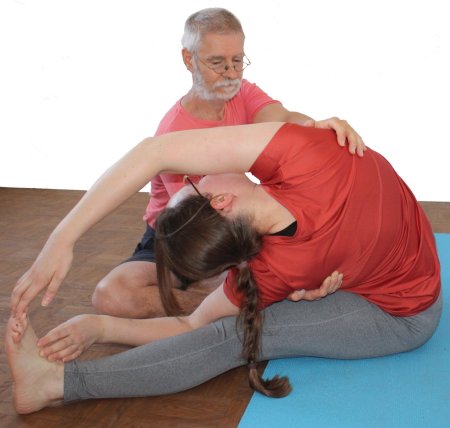
Instructions
- Take the pose as described above.
- The supporter reaches from the front of the body with the right hand between the right leg and the right arm to grasp the right shoulder from behind. The left hand is placed on the left shoulder from the front. Now the upper body is rotated as far as possible by pulling on the right shoulder and applying the same amount of pressure to the left shoulder. Applying pressure to the upper shoulder blade of the perforer in a mediocranial direction can promote lateral flexion.
Details
- The increased rotation achieved by using the supporter often means that the elbow can be placed on the floor for the first time, or if this was already possible before, then further away from the lower leg.
(P) pull on the long arm
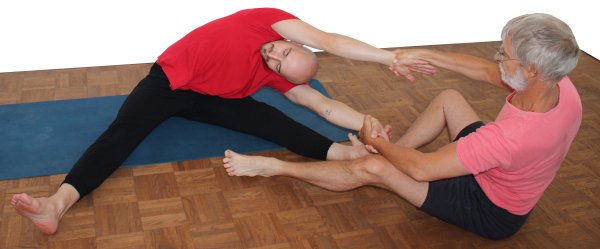
Instructions
- Take the pose as described above.
- The supporter slowly pulls the upper body more into a side bend on the right arm, using the foot to support the performer’s foot if necessary. It is also possible to pull on both arms, in which case, in addition to pulling away from the pelvis, the upper arm is pulled backwards and the lower arm is pulled forwards.
Details
- This posture can cause intensive stretching in the muscles on the back of the leg on the right as well as on the left side of the body and must be sensitively dosed.
- In principle, both arms can be pulled, but care must be taken to ensure that when pulling on the lower arm, the pull is more towards the field of vision, and when pulling on the upper arm, the pull is more towards the outside of the field of vision. In the first case, it is helpful for the supporter to position himself slightly offset from the axis of the performer’s outstretched leg towards the front (in the direction of the performer’s field of vision), in the other case slightly out of the field of vision towards the back. With the correct technique, the performer’s foot supporting the supporter’s foot can also prevent the leg from turning outwards.
(P) Keeping the thigh down
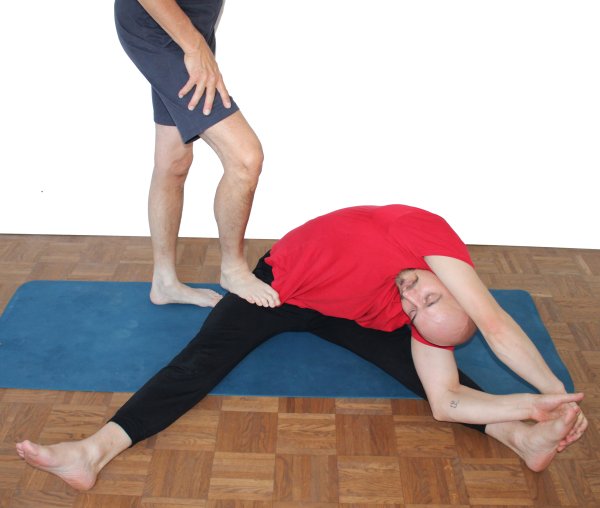
Instructions
- Take the pose as described above.
- The supporter presses with the hand or foot from above on the left thigh close to the pelvis and holds the left hip down, tending to turn the thigh out, i.e. pushes the hand or foot out of the performer’s field of vision.
Details
- Hermit deals with a detail over which the performer has very little influence in the posture, as the contralateral iliac crest is pulled away from the floor by upper body gravity with a large lever arm via the oblique abdominal muscles, among other things.
- The three known support variations can be combined with each other, whereby the combination of holding the left leg down and pulling on the arm achieves an excellent stretching effect on the oblique abdominal muscles, particularly in the insertion area on the iliac crest.
(2P)

Instructions
- Take the pose as described above.
- The first supporter pulls the performer by one arm into the torso side bend as described above, the second applies the standard support by rotating the upper body as described above.
Details
- ..
(3P) Keep thighs down
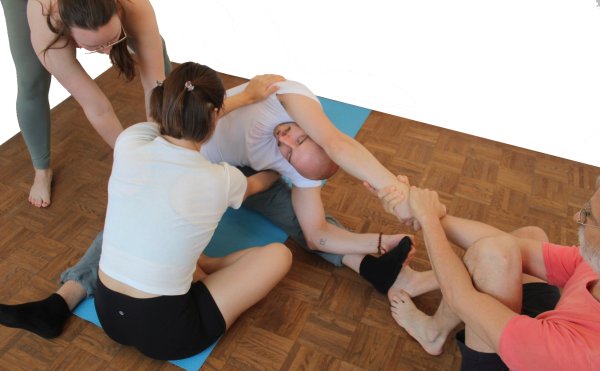
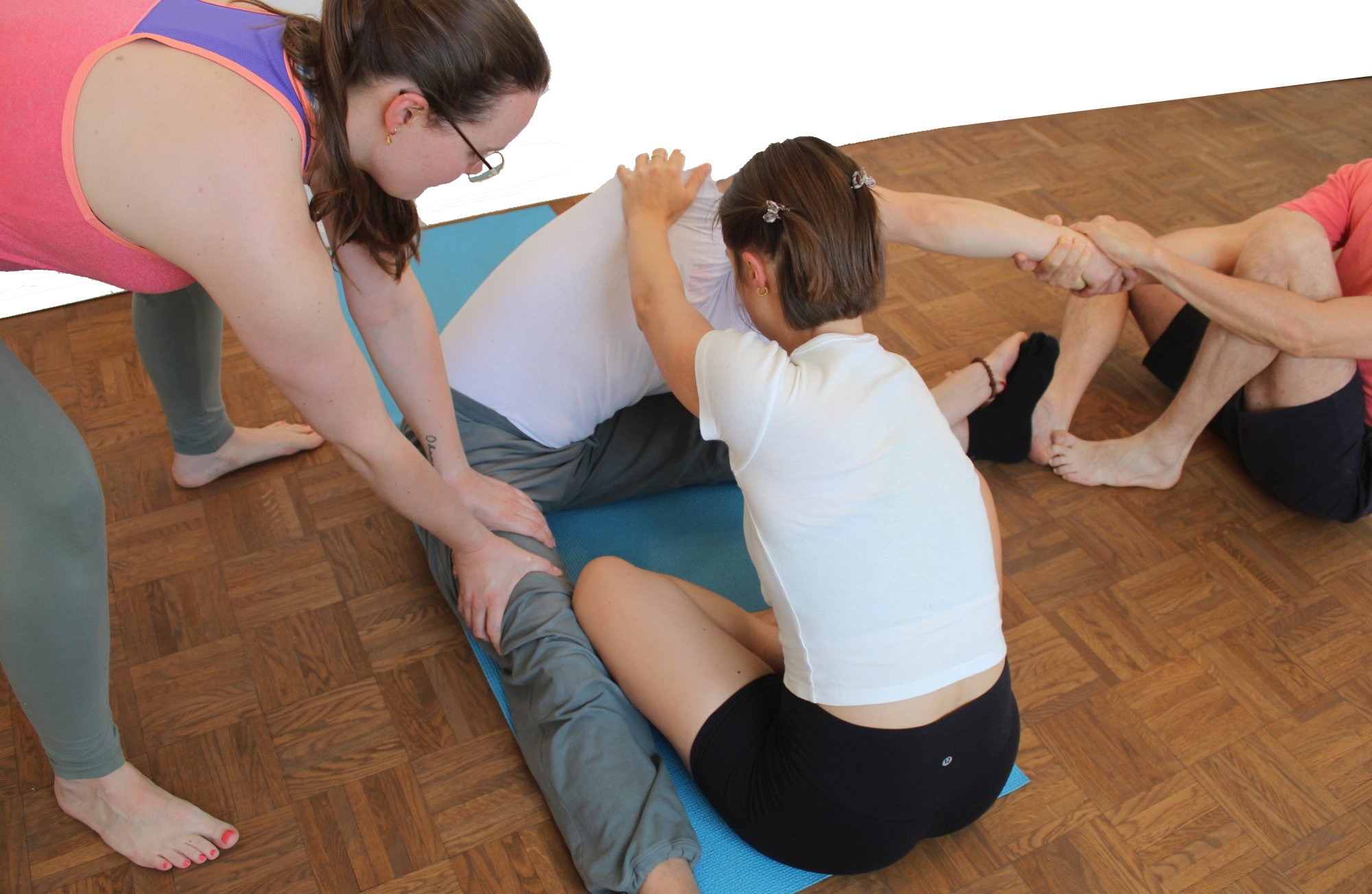
Instruction
- Take the pose as described above.
- The first supporter pulls the performer by one arm into the trunk side bend as described above, the second applies the standard support by rotating the upper body as described above and the third pushes the thigh of the contralateral leg close to the hip towards the floor with the foot or hand.
Details
- This results in complete support that prevents all important evasive movements.
